In today’s fast-paced food service world, the right container does more than just hold food – it protects your food, reflects your brand, reinforces a great customer experience, and can even help meet your sustainability goals. This is true whether you run a bustling takeout kitchen, a grocery deli counter, or a neighborhood restaurant offering delivery. The right food service container can make all the difference.
The Genpak Commercial Food Service Container Guide walks you through the essential considerations for selecting containers that meet your business needs.
- Common food container materials
- Different container types and features
- Sizing options and what they hold
- Eco-friendly packaging choices
- The best containers for delivery and takeout
Genpak helps you find the right packaging to keep your food fresh, presentable, and protected – allowing you to focus on keeping your operations running smoothly.
Food Service Container Materials
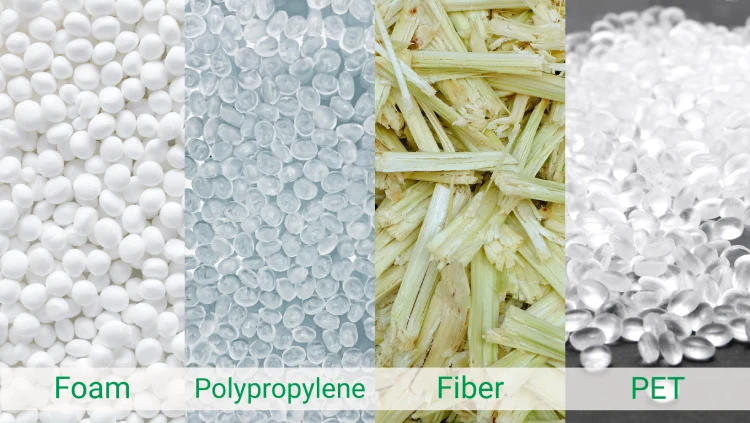
Choosing the right material is an important step in selecting the best packaging for your menu. Each material offers unique advantages depending on how the food is served, stored, and transported.
Foam
- Pros
- Excellent insulation for hot and cold foods.
- Lightweight and cost-effective.
- Cons
- Non-recyclable in some municipalities.
- May conflict with sustainability initiatives.
Best for: Budget-conscious businesses focused on heat retention, such as fast food or diners.
Polypropylene (PP)
- Pros
- Microwave-safe and heat-resistant.
- Durable and leak-resistant.
- Cons
- Not biodegradable.
- Limited recycling infrastructure in some regions.
Best for: Restaurants offering reheatable meals, soups, pastas, or curries for takeout and delivery.
Molded Fiber
- Pros
- Made from renewable materials (sugarcane, wheat straw).
- Compostable in commercial facilities.
- Strong and natural-looking.
- Cons
- Higher cost than plastic or foam.
- Can become soggy with wet or saucy foods without a lining.
Best for: Eco-conscious cafes, vegan spots, and farm-to-table restaurants.
PET (Polyethylene Terephthalate)
- Pros
- High-clarity for excellent food presentation.
- Widely recyclable.
- Cons
- Not suitable for microwaving or hot foods.
- Can become brittle in very cold temperatures.
Best for: Cold items like salads, desserts, fresh-cut fruits, or deli items.
How to Decide Which to Use
The material you choose for your containers will ultimately depend on three main factors:
- Business Needs: Fast-casual takeout demands speed and cost-efficiency, while fine dining or premium grocery items may benefit from upscale presentation.
- Environmental Goals: If your brand values sustainability, consider compostable molded fiber or recyclable plastics.
- Budget: Foam and basic plastics are more affordable, but some eco-friendly options now offer competitive pricing at scale.
Keep in mind that the selection of products that you serve may have you choosing multiple material types for your containers.
Types of Food Service Containers
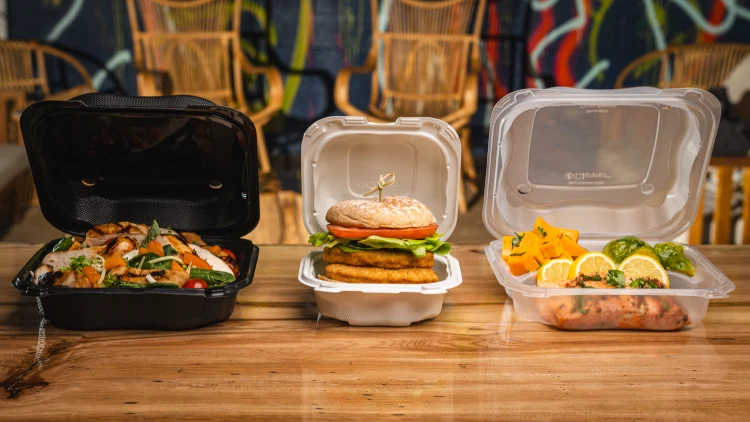
Functionality, convenience, and food integrity all come down to the design and features of your containers. Choose the one that perfectly matches your food and customer satisfaction could skyrocket. By making it easy for customers to transport orders, reheat meals and even eat from your containers, you allow customers to focus on why you started your business in the first place – your food.
Features to Keep in Mind
- Vented Lids: Prevent condensation and sogginess. This is great for fried foods and items that need to let moisture out.
- Two-Piece Containers: Separate base and lid design ideal for upscale presentations or for food that is likely to be shared.
- Hinged Containers: One-piece design makes packing fast and easy. Perfect for fast food and quick-serve restaurants.
- Compartments: Great for combo meals or separating entrees and sides
- Color Options:
- Black: Upscale look, hides stains and grease.
- Clear: Ideal for merchandising and visual appeal.
- White: Clean, simple look often used in catering or grocery.
Best use: Match features to your operational priorities — whether it’s speed, style, or structure. Your business may choose multiple container types depending on food and environment.
Size Options
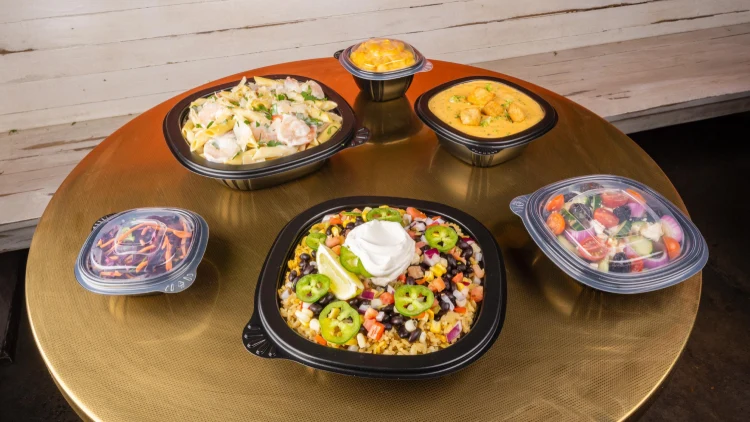
By using the right sized products, your containers reduce waste, lowers costs, and improve the customer experience. Here’s a quick guide to common sizes and their uses:
| Size | Common Uses | Examples |
| 8 oz – 16 oz | Small sides, desserts, sauces, soups | Coleslaw, mac & cheese, tiramisu |
| 24 oz – 32 oz | Entrees and combos | Pasta bowls, rice dishes, salads |
| 38 oz – 48 oz | Large meals, family-sized portions | Stir fry combos, full meals |
| 2-3 compartment containers | Multiple food components | Burger + fries, chicken + rice + veg |
Pro tip: Consider your top-selling delivery items and test how they look and travel in a container before committing.
Compostable & Recyclable Options
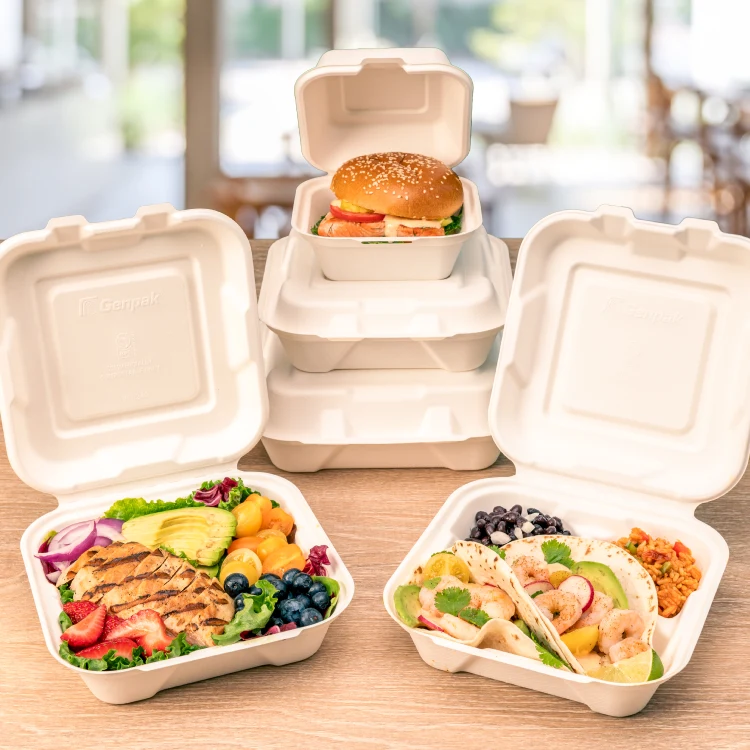
Whether your business has sustainability goals or is located in a region with eco-packaging mandates, or you just have a mind for the environment, familiarize yourself with these common food container materials:
- Compostable Materials
- Molded Fiber (Bagasse): Fully compostable, plant-based.
- PLA (Polylactic Acid): Clear bioplastic commonly made from corn; used for cold food lids or cups.
- Recyclable Materials
- PET & APET: Common for cold food packaging, widely accepted in recycling streams.
- PP (Polypropylene): Recyclable in some areas (check local guidelines).
As you shop for food containers, look for certifications on them. ASTM D6400 and ASTM D6868 are ones you’ll see for compostable products, and most of us are familiar with the labels indicating recycling codes (1, 5, etc.).
Best Food Service Containers for Delivery
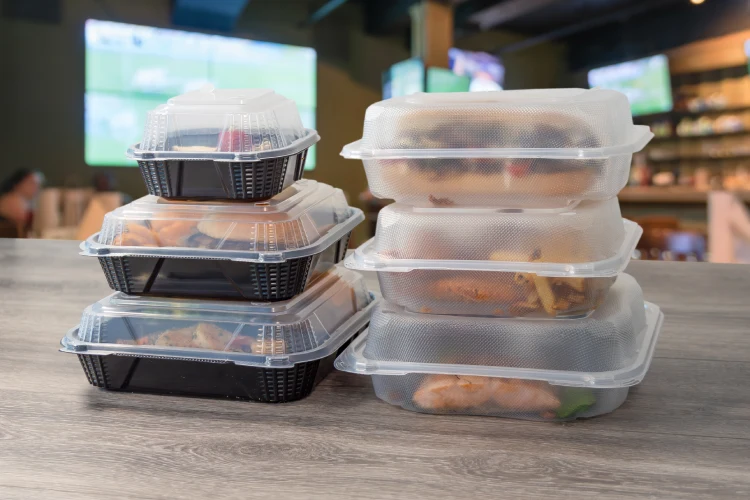
The popularity for food delivery just seems to keep reaching new levels. And oftentimes the food is delivered by a middle man, so you are not in control of the entire experience. To minimize errors and maximize the enjoyment of those who are going to eat your food, the right food container is critical. The packaging must protect quality, integrity, and presentation. Here’s what to look for as a food service business:
- Strong Structural Integrity: Avoid leaks, cracks, and collapse with thick-walled containers and secure lids.
- Stackability: Reduces the likelihood of containers sliding off one another and spilling.
- Heat Retention: Foam and polypropylene retain heat best. Vented options help with steam without losing warmth.
- Ventilation: Essential for fried or crispy items. Vented lids or breathable fiber designs prevent sogginess.
- Presentation Quality: Clear lids, compartment trays, and clean designs elevate customer experience and boost visual appeal on arrival.
Top picks for delivery:
- Polypropylene hinged containers for hot meals.
- Molded fiber with vented lids for eco-friendly delivery.
- Clear PET bowls/lids for salads and desserts.
Need More Advice on Choosing Food Containers?
The containers you use in your food service business are part of your brand experience. They are that important. And whether you’re focused on cost, performance, sustainability, or all 3, the right food service containers help deliver quality and consistency with every order.
Contact our team today for custom recommendations, samples, and pricing.
